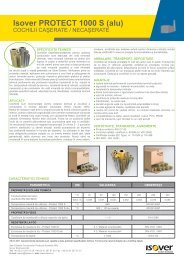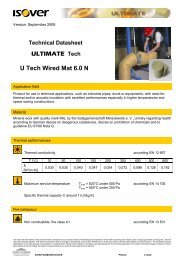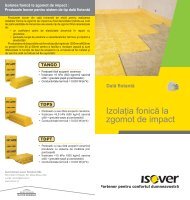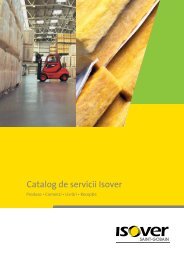ISOVER Multi-Comfort House Students Contest Edition 2013: Vision ...
ISOVER Multi-Comfort House Students Contest Edition 2013: Vision ...
ISOVER Multi-Comfort House Students Contest Edition 2013: Vision ...
- No tags were found...
You also want an ePaper? Increase the reach of your titles
YUMPU automatically turns print PDFs into web optimized ePapers that Google loves.
Invitation for Competition Submissions<strong>ISOVER</strong> <strong>Multi</strong>-<strong>Comfort</strong> <strong>House</strong> <strong>Students</strong> <strong>Contest</strong><strong>Edition</strong> <strong>2013</strong>: <strong>Vision</strong> & Reality - Glückstein QuartierInternational, two-stage, open competition
Acknowledgments:Special thanks to the City Administration Office of Mannheim for all support during the drafting of this task.Content1. General information 31.1. Contents of the competition 31.2. Who can participate 31.3. Awarding organization 41.4. Form and organization of the competition 41.5. Prize money 41.6. Time schedule 51.7. National jury 51.8. International jury 51.9. Transport and travel expenses 61.10. Legal 61.11. Possible collaboration 62. Details of the task 72.1. General information about the area covered by the contest 72.2. Site and zoning requirements 82.3. Specifics of the context 92.4. Type of construction, technical parameters 122.4.1. Construction 122.4.2. Technical parameters for thermal insulation 132.4.3. Technical parameters for sound insulation 132.4.4. Other technical parameters 132.5. Competition requirements 143. Formalities for submission 153.1. National stage 143.2. International stage 152
1. General information1.1. Content of the competitionUnder the Kyoto Protocol, more than 140 industrialnations have made a commitment to reduce theirCO 2 emissions drastically and agreed that the usageof energy-saving technologies it is a top priority inorder to save our natural resources.Overall, the building sector is responsible for 40% ofthe total energy consumption and CO 2 emissions inthe world demanding a new way of designing eachnew project and each new renovation.As the world is becoming increasingly urban, and cities are becoming larger and more densely populatedthus increasing our energy consumption as well as the CO 2 emission.Reacting to this situation, more and more local authorities are demanding for their new developmentprojects, designs that fulfil the highest requirements in terms of energy efficiency while providing the highestcomfort possible for their inhabitants.It is the case of the new “Gluckstein Quartier” development in Mannheim, Germany.The urban administration decided that for this new project the development should provide the highestdegree of comfort with the lowest possible energy consumption for the future inhabitants of the building.The participants to <strong>ISOVER</strong> <strong>Multi</strong>-<strong>Comfort</strong> <strong>House</strong> <strong>Students</strong> <strong>Contest</strong> <strong>2013</strong> <strong>Edition</strong> are required to present avision of the future development of some parts of the “Gluckstein Quartier” in Mannheim, Germany, takeninto account the existing realities.The project will require the development of residential function based on the Saint-Gobain <strong>Multi</strong> <strong>Comfort</strong>principle that will assure a natural extension of the existing neighbourhood to the North.In addition, the development shall improve the usage of the green area while creating a link with theexisting housing stock of the so called Lindenhof.1.2. Who can participate?Participants can be students of architecture, design and construction engineering from universities of allcountries with <strong>ISOVER</strong>, CertainTeed and Izocam presence and where this competition is held.Participation is open for all students from 1 st to 6 th year of study as an individual or in teams of up to 3 teammembers.Only one project may be submitted per team. <strong>Students</strong> cannot participate in the same year at 2 differentnational stages.3
1.3. Awarding organizationThe awarding organization is Saint-Gobain Insulation with the participation of national Saint-Gobain<strong>ISOVER</strong>, CertainTeed and Izocam organizations.Contact within Saint-Gobain Insulation:Gabriel GolumbeanuSaint-Gobain <strong>ISOVER</strong>18, avenue d'Alsace, 92400 Courbevoie / FranceTel.: 0033 (0)1.47.62.40.38 / Fax: 0033 (0) 1.47.62.50.48 / Mobile: 0033 (0) 6.78.41.88.59Email: gabriel.golumbeanu@saint-gobain.comThe contact details for the local <strong>ISOVER</strong>, CertainTeed and Izocam organization can be found at:www.isover-students.com/content/view/91/133/1.4. Form and organization of the competitionThe <strong>ISOVER</strong> <strong>Multi</strong> <strong>Comfort</strong> <strong>House</strong> <strong>Students</strong> <strong>Contest</strong> is a 2 stage competition: First stage – National Stageso Takes place in each country were national Saint-Gobain <strong>ISOVER</strong>, CertainTeed and Izocamorganizations are organizing the contest.o Up to three prizes will be awarded for the national stage. The project that won will receive anaward at a presentation ceremony. Second stage - International Stageo In <strong>2013</strong> the International Stage will take place between 16 to19 May <strong>2013</strong> in Belgrade,Serbia.o The winners of the National Stages will be invited to this event, together with theirprofessors. A maximum number of 3 teams from each country accompanied by one teacherper team can participate to the international stage. The final number of participants fromeach country will be decided by each local organization.o During this event the participating projects will be displayed at the exhibition for inspectionand discussion. Furthermore, the authors of the project will have the possibility to explain theconcept of the project to the jury and all the participants during a five-minute presentation. Allpresentations will be webcasted live on http://www.isover-students.como The presentations will be followed by the jury’s deliberations and the award ceremony for thewinners. The international jury will nominate the winners of the three prizes for theInternational Stage. In addition, the jury can award some special prices for extraordinaryideas provided by the participants.1.5. Prize moneyEach of the two stages of the competition can assign up to three monetary prizes for the first, second andthird place. Additionally, other prizes might be awarded by the local organization.First stage – National Stage:o Information about the prizes of the national contest stage will be provided by the local<strong>ISOVER</strong>, CertainTeed or Izocam organizations.Second stage – International Stage:o 1st prize € 1,500o 2nd prize € 1,000o 3rd prize € 750o Special prize € 500The organizer can decide to award more or less prizes than specified.4
1.6. Time scheduleDistribution of invitations for competition submissions as part of an information event: October 2012Closing date for registration for the national competition – See point 3.1 31 st March <strong>2013</strong>. Local organization can change this date to fit their local schedule. Please checkthis data with your local responsible person. All registrations have to be completed online at www.isover-students.com. Any participating teamthat fails to do so or provides incomplete or false information will be disqualified from competitionOnline training Several online training will be organized in starting November 2012 until March <strong>2013</strong>. The exactdates will be communicated thru the official newsletter of the contest to all registered participants.National jury meeting and award ceremony Completed by 1 st May <strong>2013</strong>. Local organization can change this date to better fit their localschedule. Please check this data with your local responsible personSubmission of the material for the international stage - See point 3.2 Latest by 12th May <strong>2013</strong>.International jury meeting and award ceremony: 16-19 May <strong>2013</strong> in Belgrade, SerbiaFurther information will also be provided at the lectures held at the participating universities by the national<strong>ISOVER</strong>, CertainTeed or Izocam companies. For more information, please contact your local <strong>ISOVER</strong>,CertainTeed or Izocam organization who will provide you with further details.1.7. National juryThe selection of the national winners will be carried out by a national jury. The composition of each nationaljury will be decided by the local implementing organization. The following criteria are recommended forawarding the prizes on national and international level: Design and functional concept Achieving <strong>Multi</strong>-<strong>Comfort</strong> Criteria Usage and correct mentioning of <strong>ISOVER</strong>, Certain Teed or Izocam products and solutions in theproject Sustainability - economic, ecologic and social aspects of the future function and the impact of thedesign quality1.8. International juryThe international jury will consist of architects, <strong>ISOVER</strong> experts and specialists in energy efficiencyconstructions. The organizer can modify the number or the composition of the jury without any other prioradvice. The members of the International jury will be announced at the International Stage.5
1.9. Transport and travel expensesFirst stage – National Stage:o The risks and costs of the submission of entries to the national stages shall be taken over bythe participants.Second stage – International Stage:o The forwarding of project documentation to the final international gala shall be carried out bythe respective national <strong>ISOVER</strong>, CertainTeed or Izocam Company.o Furthermore, the companies shall bear the entire travel expenses, as well as the costs ofaccommodation and lodgings for the participants at the international gala in Belgrade, Serbia1.10. LegalParticipants of the <strong>ISOVER</strong> <strong>Multi</strong> <strong>Comfort</strong> <strong>House</strong> <strong>Students</strong> <strong>Contest</strong> (the 'Competition') hereby undertakethat any information/data contained in their projects does not interfere with the intellectual property rights ofany third party, and that they either own or have full authorization to use and disclose suchinformation/data.Competition participants shall retain unlimited intellectual property rights on their projects.However, the participants to the national stage or international stage competitions, regardless of theirposition (students, teachers, <strong>ISOVER</strong> employees, IZOCAM employees, CertainTeed employees or otherattendees), hereby grant full and unrestricted authorization to Saint-Gobain Isover, CertainTeed and Izocam(the "Organizer"), free of charge, to use and publish their projects, project presentations and all materialsubmitted by or representing the participants, including, but not limited to, photos or videos taken of theparticipants at the contest and/or material provided by the participants to the Organizer for the contest, foran unlimited period of time and for all media publication used by the Organizer.Competition participants acknowledge that the decision of the jury is final. All participants hereby accept theincontestable and definitive nature of the jury’s decisions.By participating in the competition, the participants acknowledge and accept the conditions presented here.1.11. Possible collaboration between participants and the City Administration of MannheimThe participants are informed that the representatives of the City Administration of Mannheim will attend theInternational Stage.The City Administration of Mannheim might be interested by some of the exposed ideas in which caseseparate discussions between the City Administration and the authors will take place.6
2. Details of the task2.1. General information about the area covered by the contestFigure 1 - Site mapMannheim is a city with huge potential for development. Together with Heidelberg and Ludwigshafen,Mannheim forms the backbone of the Metropolregion Rhein-Neckar. The structure of the city ischaracterized by the inner-city, which is surrounded by the main street circle. At the south-western endadjacent to the palace of Mannheim (a copy of Versailles) the ICE railway line can be found.The development area set for this contest contains the area directly opposite to train station. It has thehighest priority in regards to the town planning as it is the connection between the neighbourhood ofLindenhof-Area and Inner-City. In 2001 a high-rise building (“Victoria Turm”) was completed at the westernend of this area. It emphasizes the beginning of the area stretching along the railway system. Also finishedby now is the Lanz-Carrè, Glückstein-Carrè and MAFINEX building.There are two old operating buildings of “Deutsche Bahn” in the middle of this area: an engine hall and aformer workshop building. Both buildings must be restored. The engine building is protected as a historicalbuilding.These buildings will be the new center of the area. It`s most important to find an answer on how toconnect these area with the existing Lindenhof and new build Glückstein-Carrè building ensemble.The road planning determines the relocation of the main development road between the historic structuresand the park.7
2.2. Site and zoning requirementsThe size of the whole development area is 6.4 hectares. The contest will focus on a selected section. Thissection is marked as Area “A” and Area “B”.Area “A” – This area is dedicated to theresidential function. A number of maximum 4buildings with a maximum height level of groundfloor + 4 floors shall be constructed in this area.The final buildings should provide altogether agross floor area of approximately 10.440 sq. m. Asa premium-quality residential development isplanned, the size of the flats shall be aboveaverage.The estimated number of flats isestimated below 150 apartments.Integration of new residential function is not limitedto the layout presented in the “Area A, Figure 2 –Site functions”. However the overall design andthe façade of the new construction should fit withthe surroundings area.This area also contains the historical buildings aswell as the park. The task is to find a sustainableusage for both this spaces as well as a good linkbetween the park area and the existing buildingstock of “Lindenhof” in the South-West and the twohistoric buildings and the new development to the North-Est.Figure 2 - Site functionArea “B” - This area is for both non-residential and residentialusage. The task of the contest for this part is to create amaster plan and a design for the building shapes, facades andthe exterior green taken in to account office, service andscience functions as well as residential function.The height level for this area is: Residential: ground floor + 5 upper floors Non-residential: ground-floor + 5 upper floorsFigure 3 – Zone B height levelsFormerly, there were planned 3 high-rise buildings in “Area B”.According to the current state of planning only two high-risebuildings will be building: Block 1 and Block 2 as indicated inthe right picture. The height of these two buildings is: groundfloor + 11 upper floorsIn Area B altogether approx. 14 % of the surface should beconstructed for the residential function. The residential useshould be located as follows Ca. 23 % residential use in Block 2 Ca. 23 % residential use in Block 3.More information about area Area “A” and Area “B” can be found in the file “Plan zoning <strong>2013</strong>.pdf”.8
The contest requests only the development of “Area A” and “Area B”. Details and calculation arerequested only for one building with residential function in “Area A” (see “2.5. Competitionrequirements”). This building should achieve <strong>Multi</strong>-<strong>Comfort</strong> <strong>House</strong> criteria. However all buildings (in ‘Area A’ and ‘Area B’) should achieve the building physics performance ofa <strong>Multi</strong>-<strong>Comfort</strong> <strong>House</strong> (including the two historical building after renovation.)Beside constructional, the social and economic aspects also have to be considered and respected and thebuildings designed should give a new impulse to the existing urban area.The architecture of the neighbourhood has to fit in the surrounding of the site. Urban space solutions for theimmediate surroundings of the site will be proposed.The overall scope of the task is to get actively involved in giving shape to future development of living inEuropean cities.2.3. Specifics of the contextThe two historical buildings can be found in Area A. One is aformer engine shed and the other one is an assembly hall.These two buildings shall be maintained. They form “themiddle” of the whole facility and shall host amenitiescontribute to enlivening the Glückstein-Carrè.Between the historical buildings and the existing Lindenhofdevelopment there can be found the park that forms theconnection between the two grown structures. This should becovered partly on its North-East part with the residentialfunction that will be developed (see “Figure 2 - Site function”).The proposed architectural solution has to correspondboth with the existing constructions of Lindenhof and thenew development that can be found at the Lanz-Carrèand Glückstein-Carrè.Figure 4 – Engine hallFurthermore a connection between the new and existingbuildings should be built.Figure 5 – Assembly hall (front) and engine hall (back)Figure 6 – Assembly hall (right) and engine hall (left)9
The basic structure for the development of “Area B” is given in the “Area B Figure 2 – Site functions” as wellas in “Figure 3 – Zone B height levels”. Here an appealing architecture in coordination with the externalarea is desirable. The architecture shall harmonize with the adjacent properties of the Glückstein-Carrè andthe MAFINEX technological centre. It is recommended that the final layout of the buildings footprintmatches the layout presented in “Area B Figure 2 – Site functions” and “Figure 3 – Zone B height levels”.Figure 7 – MAFINEX technology centreFigure 8 – Lanz Carrè buildingFigure 9 – Sit viewAs can be seen from the bird´s eye view the area will be connected to the Lindenhof through the territorialdevelopment and complemented by it. The main streets have to be relocated. The traffic on those streets ishigh; therefore noise pollution has to be handled. A large degree of noise is also produced by the tracksystem of the railway station nearby. Further information on the noise can be found in the contestdocuments.10
The urban development approach is to build a building complex, with mainly non-residential to the noisysurrounding and residential usage to the more silent court yard, along the main development axis andparallel to the railway system. So single construction fields are created which are covered by surroundingbuilding blocks.The north-western part of the area is under development at the moment. This is bordered by the “newmiddle” with its two historical buildings. Here the public life of the quarter shall take place.Keeping the existing buildings, an alternative usage including their surroundings, shall be implemented forthese two constructions. Participants will consider also an energetic refurbishment (to the level of MCH asalready mentioned) but the detailed description of this treatment are not mandatory. The external area shallemphasize the public usage and provide the connection to the park on the south.The residential construction envisaged for the Hanns-Luck Stone Park has to respond to the demand of thespatial connection between the green area and the historical structures. The development has to be incontext with the newly built buildings Lanz-Carrè, Glückstein-Carrè and MAFINEX technological centre.Proposals are expected for "urban villas". They can be designed up to a building height of ground floor + 5floors. Most important will be to keep an open view between the existing Lindenhof and the historicalbuildings. Proposals should also be made for the design of the walkways across the green/park tostrengthen the relationship between all existing buildings.The surrounding block construction with commercial usage is continued at the south end of the territory.Suitable facade architecture, energetic optimization and a cooperating external area (on master plan levelonly) shall be designed.The whole area will be connected to the district heating pipe. There is no need for the design of a separateheat supply.11
2.4. Type of construction, technical parametersThe high-performance thermal, acoustic, fire protection and daylight requirements have to be considered inorder to achieve the <strong>Multi</strong>-<strong>Comfort</strong> criteria. A presentation of the <strong>Multi</strong>-<strong>Comfort</strong> concept is available fordownload at www.isover-students.com.In the course of the competition, lectures on this subject will be held at the faculties as well as clinical trials.The <strong>Multi</strong>-<strong>Comfort</strong> criteria for the residential function are presented below.Figure 10 – Saint Gobain <strong>Multi</strong> <strong>Comfort</strong> CriteriaParticipants are expected to undertake calculations on a residential building to prove this achieve SaintGobain <strong>Multi</strong> <strong>Comfort</strong> criteria of: annual heat demand < 15kWh/m2 annual cooling demand < 15kWh/m2 the other criteria presented in “Figure 10 – Saint Gobain <strong>Multi</strong> <strong>Comfort</strong> Criteria”Calculations will be done using <strong>ISOVER</strong> Designer (version 2 or version 3). The tool is available fordownload at www.isover-construction.com Calculation can also be done by using PHPP (Passive <strong>House</strong>Planning Package)2.4.1. ConstructionThe construction method (load-bearing, wood, steel construction, etc) can be chosen freely by theparticipants, but the integration of <strong>ISOVER</strong>, CertainTeed and/or Izocam products as parts of theconstruction build-up is strongly recommended.<strong>ISOVER</strong> shall provide free planning assistance in the form of: Construction CAD details online data base:www.isover-construction.como First data base in the world containing morethan 150 joint construction details, thermalbridge free for 4 different construction systems.o All these details have been certified by thePassive <strong>House</strong> Institute and using it assuresthermal bridge free construction.o The access is free and the application provides:CAD drawings with different download options,components and products, key figures,isotherms, model and materials, air tightnessconcept.Figure 11 – <strong>ISOVER</strong> Construction details12
Air tightness website: www.isover-airtightness.como All relevant information about the achieving air tightness: methods, products and solutions,concept importance.<strong>ISOVER</strong> Designer Calculation Tool and Brochures containing literature about <strong>Multi</strong>-<strong>Comfort</strong> conceptfor new construction and renovation can be found at www.isover-construction.comFurther Information about the local <strong>ISOVER</strong>, CertainTeed and Izocam organization can be found on theofficial contest website www.isover-students.com/content/view/137/1612.4.2. Technical parameters for thermal insulationThe main scope is to achieve: An annual heat demand 57 (1/BTUITh-1 ft-2 0F -1) for noncompactbuilding shape Windows and doors UW total ≤ 0.8 W/m2K, or R > 7 (1/BTUITh-1 ft-2 0F -1). The ‘g’ value should bechosen based on the solar heat gain evaluations taking in to account both cold and warm season.2.4.3. Technical parameters for sound insulationDepending on the future function of the building parts the sound protection concept has to be considered.The airborne and impact sound insulation of the residential function have to take in consideration theacoustic criteria.The following acoustic criteria are targeted for the residential function.From exterior noise (houses): Maximum level of noise inside the apartments Lden 20dB.Between dwellings (houses): Airborne sound insulation between dwellings DnT,w ≥63 dB Impact sound insulation between dwellings: LnT,w ≤ 40 dBInside dwellings (inside the house) Airborne sound insulation between the rooms in the dwelling (without the doors) DnT,w ≥48 dB Impact sound insulation in the dwelling: LnT,w ≤ 45 dBIn practice, sufficient sound insulation for windows and doors, as well as for sanitary installation andventilation systems should be considered for residential and non-residential usage.2.4.4. Other technical parametersProtection against overheating in summerSufficient sun protection needs to be planned to reduce summer overheating. The ratio of transparent toopaque components also needs to be taken in account.Furthermore the frequency of overheating of more than +25°C or +77°F indoor temperature must be lessthan 5%.Fire protectionAll bearing internal and external walls have to achieve at least REI 60 according to ISO standards,The roof and ceilings have to achieve at least REI 60 according to ISO standards,All non-bearing internal walls between different functions (depending on the function) have to achieve atleast REI 30 according to ISO standards.13
Natural daylightNatural daylight autonomy should be achieved for at least 60%, on a yearly basis for living spaces.2.5. Competition requirements2.5.1. Minimum requirements (obligatory)The following minimum requirements for descriptions and plans must be considered. Participants areadvised to choose appropriate scales for all drawings based on the poster sizes outlined in section 3.1 and3.2 and the participant’s individual design ideas and directions to allow appropriate detail and clarity to bereviewed by the judges.A. Master plan Plan proposal indicating the proposed functions and connection with existing surrounding in Zone Aand Zone B Experience of living in the analysed zones (Zone A and Zone B) Visualisation of the connection on NE- SW axe between existing residential area, new residentialand preserved historical buildings.B. Residential functionThe following information should be presented at least for one residential building in zone ATypical floor plan(s)Cross-section(s)Views, perspectives and/or photographs of physical modelsConstruction details:o Horizontal facade cross-section (suggested scale 1:50)o Vertical facade cross-section (suggested scale 1:50)o Roof, external wall and ground floor interface details (suggestedscale 1:20 / 1:10)o Other details as see fit by the participants<strong>ISOVER</strong> Designer calculationso Calculation overviewo Calculation can be done using <strong>ISOVER</strong> Designer version 2 orversion 3 or calculation software PHPPAny additional information considered necessary by the participantsC. DescriptionsParticipants are advised to furnish the necessary text / diagrams on thesubmitted posters to allow judges to suitably understand the scheme.This may include; Functional solution Design concept Description of construction U-values Energy supply and overall sustainable conceptFigure 12 – Overview Designer 2Participants may include additional calculation, drawings or information about the usage of energy,renewable sources, ecology or others points) to better explain their scheme.14










